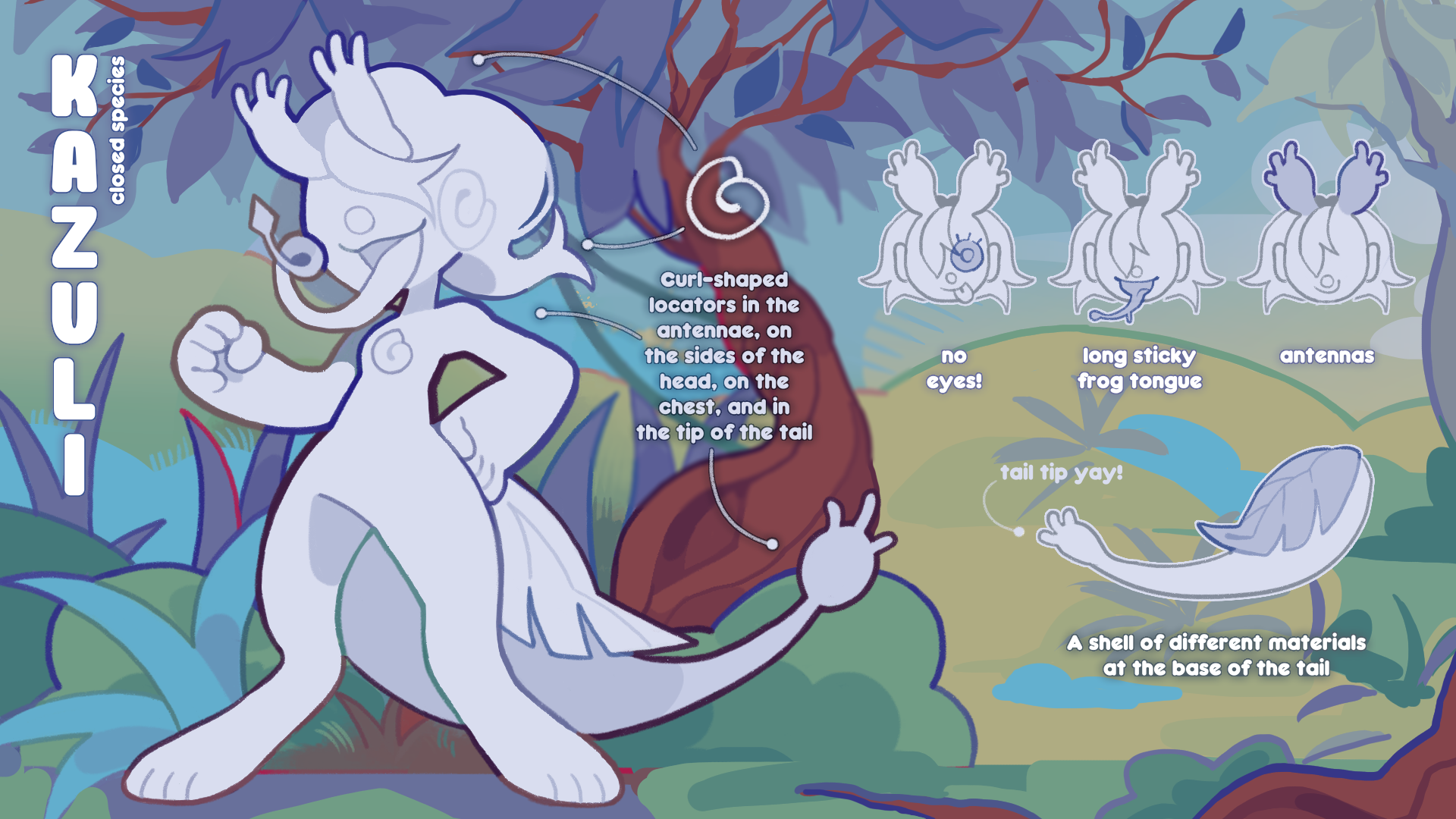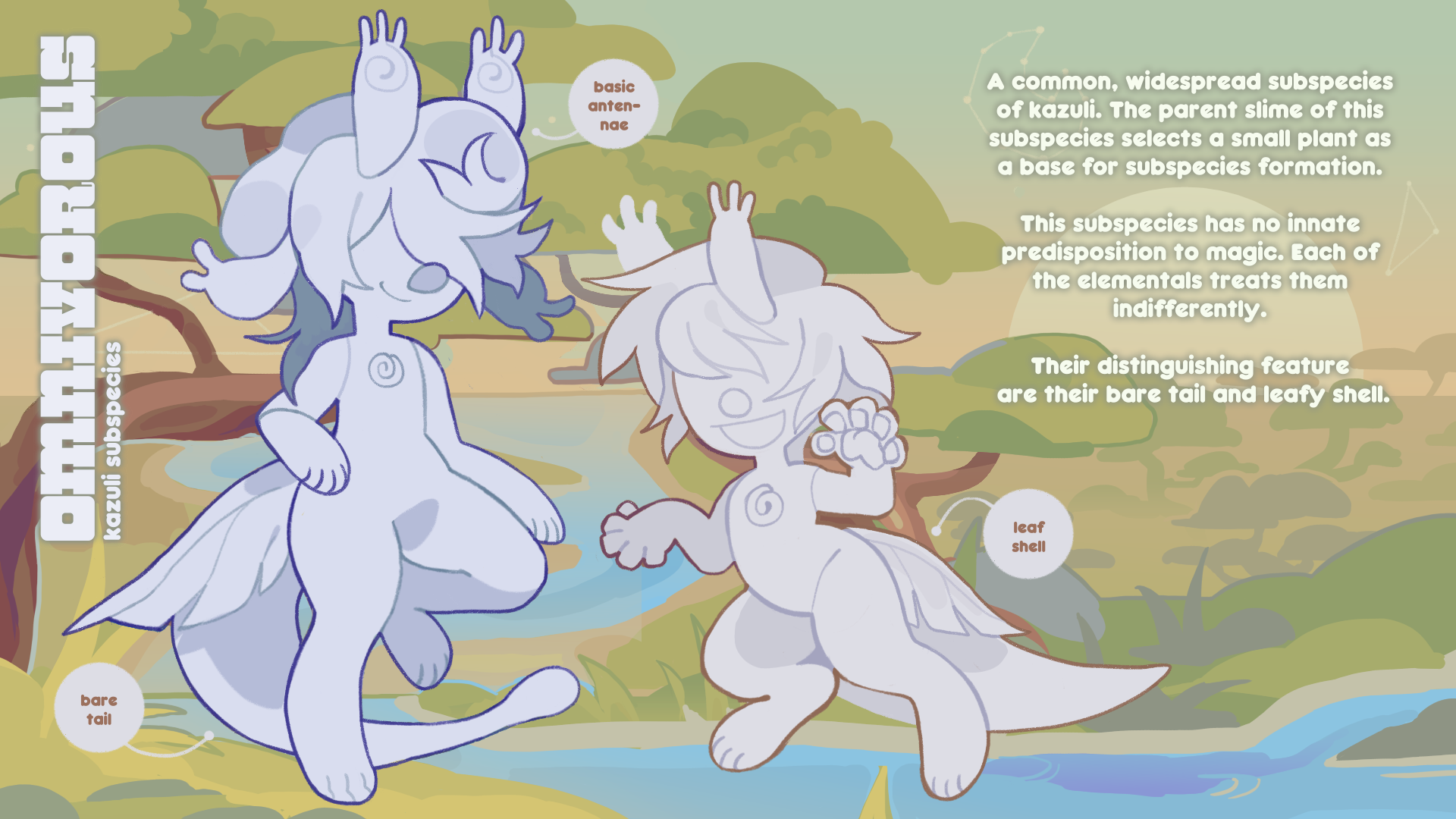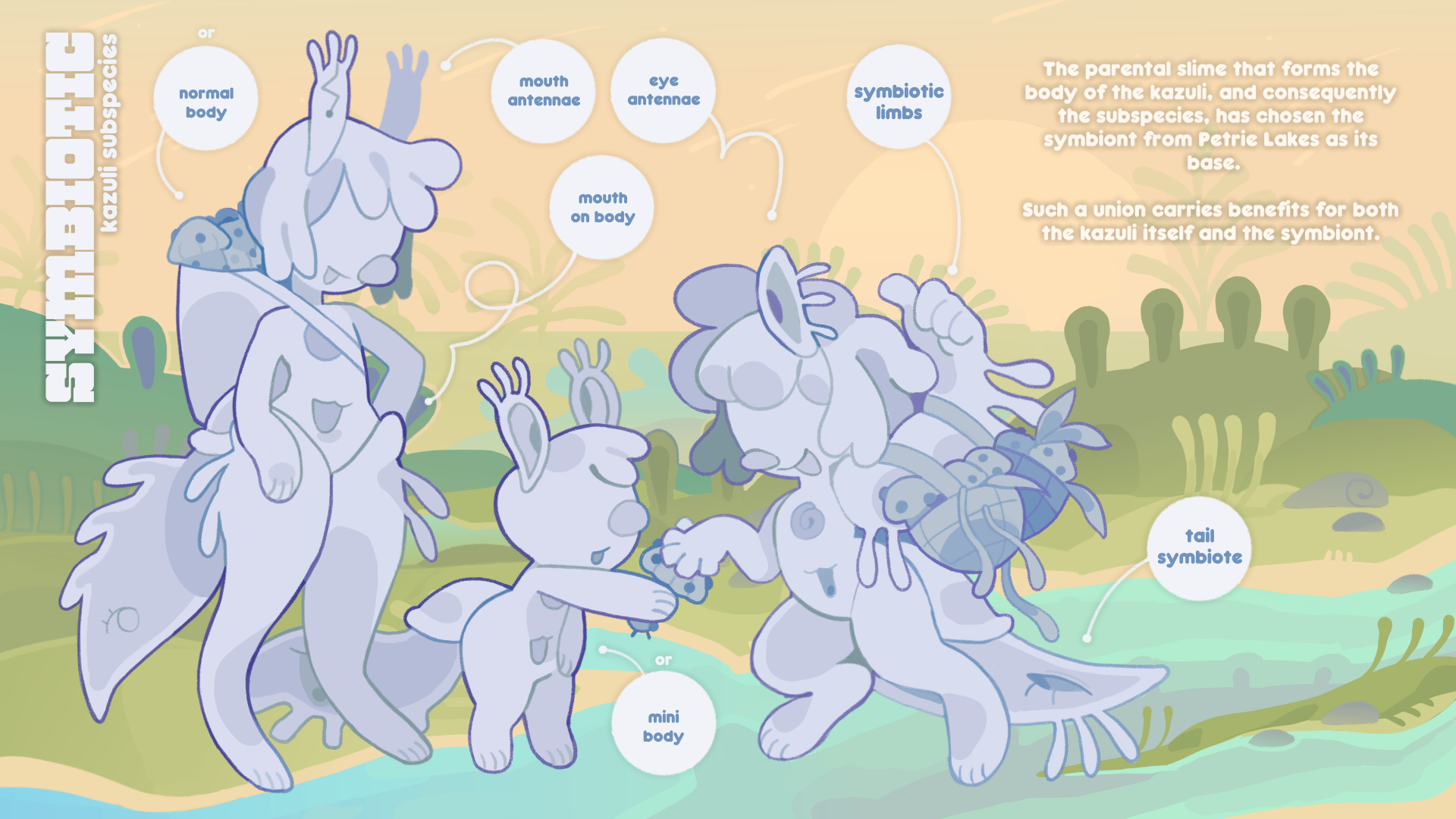
Content
- presence of antennaes (appearance varies by subspecies)
- presence of shell (appearance varies by subspecies)
- presence of "clown" nose (appearance varies by subspecies)
- presence of chest locator
- presence of distinctive features of the subspecies
Subspecies ~ omnivorous , forest , cave , river , avian , deepwater , urban
Anatomy
Kazuli are creatures that choose a base (plant, animal, or object) and use it to form their bodies. Their subspecies correspond to the absorbed base, and depending on the subspecies, they have certain traits.
A Kazuli's body consists of slime, spores, and a pinch of magic. Kazuli have an anthropomorphic appearance and resemble animals, but still move on two legs (hind legs), and have arms (forelegs) with which they can pick up objects and use tools. The outside of their body is covered with skin that feels like a mushroom stalk. The skin can be covered with silky moss and grass that resembles hair and fur thanks to a pinch of magic. Inside their body is a skeleton of roots, compacted mucus, or bones that supports the body and makes it capable of grasping, jumping, running, and other activities! Inside the body of Kazuli except for the skeleton and absorbed object there is slime, which dissolves all the food, get into the body of Kazuli.
Shape of the body (more or less plump), the volume of hips, torso, muscles and other things depends on the desire of the Kazulii itself. The only limitations are that Kazuli has no nipples and genitalia.
Kazuli's head can be one of the variations given. Of course, depending on your artstyle, the head can be different, but the main thing is that the deviations are not too big and the shape remains recognizable.
Kazuli have a small round nose on their face, which they use to touch other Kazuli or objects. By rubbing their noses on each other, Kazuli get to know each other and pass on information about themselves. These actions are mostly associated with friendly, familial, or romantic relationships.
They also have a mouth on their face with a tongue inside, which is similar to a frog's tongue. Inside the mouth, the tongue is compressed like a spring, and when a Kazuli wants to grab something, it opens its mouth and shoots out its tongue, grabbing the object. The object sticks to the tongue and then the tongue returns to the mouth with the object. Once inside the Kazuli's body, the object moves in the slime and eventually dissolves, saturating the Kazuli.
The kazuli skin can be any color and have any pattern as long as the pattern does not mimic other traits. The coloring can include gradient, text, numbers, abstract designs, and so on.
If you want your Kazuli to be canonical, it would be better not to use text and numbers in the pattern, as well as parts of human culture, since kazuli are not familiar with it and do not exist in the world together with humans.

Antennas
Each Kazuli has antennae located on the top of its head. The antennas help the Kazuli navigate through space. Inside them is an air locator that picks up the aura of other creatures or objects and emits its own aura. The air locator looks like an elongated tube twisted into a spiral.
Antennas can be opaque and smooth, or opaque and with a spiral on the skin surface, or transparent if the "transparency" trait is applied to them. Antennas can be translucent down to the air locator.
Depending on your artstyle, the antenna and air locator can be more or less rounded, but it is important that the rounded shape is still readable.
Depending on the subspecies, the shape of the antennas may vary. The antennae have three small outgrowths on their tip. Depending on the shape of the antenna, there may be more or fewer branches, but by default there are three.
Ear shells
Kazuli has ear shells on the sides of its head. These allow them to find water and pick up the aura of creatures and objects underwater. This is more useful for those subspecies that live in bodies of water, but since all Kazuli do not need air, they can choose their own habitat and live even underwater, regardless of subspecies.
The ear shell can be one of three possible shapes:
- The first shape is spiral or completely round.
- The second shape is round or spiral with a large outgrowth at the bottom with 2 smaller outgrowths at the bottom.
- The third shape - the ear drum is attached to the head by its thin part, which widens towards the end. At the end of the large part are two small outgrowths.
The water locator works whether ear shell is visible or not, so full coverage with hair, clothing or accessories is allowed. Ear shells can take on various bizarre shapes if they have been mutated.
Chest locator
Kazuli has a chest locator on its chest, which regulates its body temperature and also recognizes the temperature of surrounding objects. The fire locator may be concealed by a flat or spiral circular shell, or may not be concealed at all and is on top of the body in its present appearance.
The shell should also not have a hole in the middle. The fire locator is usually located in the middle of the shell, which is why there should be no holes in the middle of the shell either!
The shell that the fire locator is covered in can take any shape, but this is considered a mutation. It is important to keep the size of the shell - it should not be too big or too small.
Tail tip
The tip of the tail has a ground locator, which Kazuli use to strike the ground when communicating with other individuals of their species. With the development of Kazuli society, the earth locator and tail tip are no longer relevant, as Kazuli now have speech and writing. The earth locator is most prominent in plant and cave Kazuli, but increasingly there are individuals that lack the earth locator and tail tip accordingly. When creating a character, you do not need to draw a tail tip unless you want your Kazuli to be able to communicate by beating on the ground.
The tip of the tail is usually round, but can take on other unusual shapes if they have been mutated.
Shell
At the base of the tail (the place where the tail grows from) is a shell that protects a special place in the tail - the one where the embryo can be found. Depending on the subspecies, the carapace may be more or less strong, made of different materials, or have spines or spurs on its surface.

Omnivorous subtype shells:
- a soft shell made of plant material and having a curl at the end of it;
- dissected leaf, has a single base but diverges at several ends;
- a solid leaf has one large shape and usually has no more than two ends;
- the floral shell consists of the leaves of the flowers and the offshoots attached to the flowers, such as whorls or stamens.

Forest, cave, avian subtype shells:
- For forest and cave subspecies, the tail shell is the same. Of course, it is worth considering that the cave subspecies also has a shell on the head, which distinguishes them from other subspecies;
- The avian subspecies may have the same carapace as the forest subspecies, but this subspecies also has a segmented shell and wing-imitating shell.

River subspecies shells:
- Round seashell with curl;
- Triangular shell with curled shape;
- Shell with a hole that shows the tail;
- A bivalve shell that has parts at the top and bottom.

Deepwater subspecies shells:
- The deep-sea shell has several variations, and can also create a combination of existing variations;
- Thin shell with ruffles;
- Thick shell with small oval spurs;
- A shell consisting of many rounded elongated outgrowths;
- A soft and light shell that looks like a cloud;
- A shell with a curl at the end with tentacles;
- Jellyfish-like shell.
Subspecies

❧ Omnivorous ☙
Rarity: common
A common, widespread subspecies of kazuli. The parent slime of this subspecies selects a small plant as a base for subspecies formation. This subspecies has no innate predisposition to magic. Each of the elementals treats them indifferently. Their distinguishing features are their bare tail and leafy shell.
The absorbed object is: plant
Special traits of the subspecies:
- Bare tail - mandatory trait of the subspecies
- Leaf Shell - mandatory subspecies trait
- Fur - optional subspecies trait
All of the above traits, excluding mandatory traits, can be freely added and removed during redesign. Mandatory traits are subspecies-defining traits that make the character recognizable as a kazuli of the Omnivorous subspecies.
Until May 31st inclusive: You are free to add traits relating to body vegetation to the Omnivorous (formerly Plant) subspecies, including plant tail. We will tweak the traits ourselves if necessary and add the necessary mutation traits for free. Vegetation includes: fruits, mushrooms, sprouts, leaves, branches with leaves, moss, mycelium, grains, and a plant tail consisting of roots, stems, and branches.
❧ Всеядный ☙
Редкость: common
Обычный, широко распространенный подвид казюли. Родительская слизь этого подвида выбирает небольшое растение в качестве основы для формирования подвида. У этого подвида нет врожденной предрасположенности к магии. Каждый из Элементалей относится к ним равнодушно. Их отличительными чертами являются голый хвост и листьевой панцирь.
Поглощенный объект: растение
Особые признаки подвида:
- Bare tail - обязательный признак подвида
- Leaf Shell - обязательный признак подвида
- Fur - опциональный признак подвида
Все вышеперечисленные черты, за исключением обязательных черт, могут быть свободно добавлены и удалены во время редизайна. Обязательными являются те черты, которые делают персонажа узнаваемым как казюли Всеядного подвида.
До 31 мая включительно: Вы можете свободно добавлять признаки, относящиеся к растительности на теле, к Всеядному (ранее Растительному) подвиду, включая растительный хвост. При необходимости мы сами подправим эти признаки и добавим необходимые мутационные признаки бесплатно. К растительности относятся: фрукты, грибы, ростки, листья, ветки с листьями, мох, мицелий, злаки, а также растительный хвост, состоящий из корней, стеблей, веток.
Forest
Rarity: uncommon
Absorbed small woolly animals living in forests and foothills have taken the form of forest kazuli. They dwell predominantly in forests. They require water, food, warmth and other things for sustenance, but their main diet consists of meat, grass and berries in the wild and crops in urban areas.
Up to and including May 31: Your common kazuli myo gives you access to the forest subspecies up to and including May 31.
❧ Cave ☙
Rarity: uncommon
An uncommon subspecies of kazuli that prefers a nocturnal, cave-dwelling lifestyle. Due to their insectivorous diet, kazuli of this subspecies are only common underground. The Fire Elemental favors this subspecies, which is why they have an innate predisposition to fire magic. The distinctive feature of this subspecies is also that their antenna is present in a single variant and always on the forehead - all because of the head shell.
The absorbed object is: beetle / insect
Special traits of the subspecies:
- Insect tail - mandatory subspecies trait
- Hard Shell - mandatory subspecies trait
- Head Shell - mandatory subspecies trait
- Fur - optional subspecies trait
- Spikes - optional subspecies trait
- Shell horns - optional subspecies trait
- Insect parts - optional subspecies trait
All of the above traits, excluding mandatory traits, can be freely added and removed during redesign. Mandatory traits are subspecies-defining traits that make the character recognizable as a kazuli of the Cave subspecies.
❧ Пещерный ☙
Редкость: uncommon
Необычный подвид казюли, предпочитающий ночной, пещерный образ жизни. Из-за своей насекомоядной диеты казюли этого подвида распространены только под землей. Элементаль огня благоволит этому подвиду, поэтому у них есть врожденная предрасположенность к магии огня. Особенность этого подвида также заключается в том что их антенна присутствует в единичном варианте и всегда на лбу - все из-за головного панциря.
Поглощенным объектом является: жук / насекомое
Особые черты подвида:
- Insect tail - обязательная черта подвида
- Hard Shell - обязательная черта подвида
- Head Shell - обязательная черта подвида
- Fur - опциональная черта подвида
- Spikes - опциональная черта подвида
- Shell horns - опциональная черта подвида
- Insect parts - опциональная черта подвида
Все вышеперечисленные черты, за исключением обязательных черт, могут быть свободно добавлены и удалены во время редизайна. Обязательными являются черты, определяющие подвид- те которые делают персонажа узнаваемым как казюли пещерного подвида.
River
Rarity: uncommon
Absorbed near-water dwellers has taken the form of river kazuli. Their bodies require constant hydration and more water intake, so they live near freshwater bodies or in swamps. This subtype feeds on vegetables, fruits, meat, insects, shells and corals.
Avian
Rarity: uncommon
The takeover of flying animals, has taken the form of the avian kazuli. They rarely lead sedentary lives, preferring to nomadize and fly to warmer regions. They require water, food, warmth, and the like for sustenance, and are omnivorous with no particular diet.
Deepwater
Rarity: rare
Submerged underwater animals has the form of deepwater kazuli. They spend most of their lives underwater, occasionally rising to the surface. They require constant hydration, food, and water. This subtype feeds on fish, coral, shells, crustaceans, and algae.

❧ symbiotic ☙
Rarity: modified
The absorbed object is: symbiont that looks like a microbe, amoeba, or cell.
The parental slime that forms the body of the kazuli, and consequently the subspecies, has chosen the symbiont from Petrie Lakes as its base.
Such a union carries benefits for both the kazuli itself and the symbiont. However, kazuli of the symbiotic subspecies molded in an unusual way have a small, shrunken body and cannot grow to have a regular or long body. Nevertheless, to become even smaller they may well do so! Regardless of the size of the kazuli itself, the tail always remains the same.
The symbiote has formed a tail and is attached to the clavicle of the kazuli. The symbiont itself is a separate entity with its own needs, although it is not intelligent. On the tail symbiote can be located either a mouth, through which the symbiote consumes food, or an eye, which transmits visual information to the kazuli. In addition, the symbiont can also give the kazuli symbiotic limbs.
Special traits of the subspecies:
- Symbiotic tail - mandatory trait of the subspecies
- Symbiotic limbs - optional subspecies trait
- Eye Antennas - optional subspecies trait
- Mouth Antennas - optional subspecies trait
- Mouth on body - optional subspecies trait
Magic:
- Pure magic (earth, innate) - A magical trait of the subspecies that can be added with the item “Diamond Tincture”.
- Combined magic (plant or crystal) - A magical trait of the subspecies that can be added with the item “Diamond Tincture”, in combination with a change in the form of essence;
- liquid essence for plant magic;
- flame essence for crystal magic.
All of the above traits, except for the tail, can be freely added and removed during redesign, excluding mandatory traits. Mandatory traits are subspecies-defining traits that make the character recognizable as a kazuli of the symbiotic subspecies.
Симбиотический
Редкость: modified
Родительская слизь, формирующая тело казюли, а соответственно и подвид, выбрала в качестве основы симбионта из Озер Петрий.
Такой союз несет в себе выгоду как для самой казюле, так и для симбионта. Однако сформированные необычным образом казюли симбиотического подвида имеют маленькое скукоженное тело и не могут вырасти, иметь обычное или длинное тело. Тем не менее стать еще меньше они вполне могут! Вне зависимости от размеров самой казюли, хвост всегда остается прежним.
Симбионт сформировался в виде хвоста и прикреплен к ключице казюли. Сам по себе этот симбионт является отдельным существом со своими потребностями, хоть и не является разумным. На хвосте-симбионте может располагаться либо рот, благодаря которому симбионт потребляет еду, либо глаз, который передает визуальную информацию казюли. Помимо этого, симбионт также может нарастить казюле симбиотические конечности.
Особые черты подвида:
- Symbiotic tail - обязательная черта подвида
- Symbiotic limbs - опц. черта подвида
- Eye Antennas - опц. черта подвида
- Mouth Antennas - опц. черта подвида
- Mouth on body - опц. черта подвида
Магия:
- Чистая магия (земли, врожденная) - Магическая черта подвида, которую можно добавить с помощью предмета "Алмазная настойка";.
- Смежная магия (растительная или кристаллов) - Магическая черта подвида, которая может быть добавлена вместе с предметом "Алмазная настойка", в сочетании с изменением формы эссенции;
- эссенция жидкости для растительной магии;
- эссенция огня для кристальной магии.
Все вышеперечисленные черты, кроме хвоста, могут быть свободно добавлены и убраны при редизайне, исключая обязательные и дополнительные черты. Обязательные черты являются определяющими для подвида, благодаря которым персонаж распознается как казюли симбиотического подвида.
Urban
Rarity: limited
A subspecies that selects for items near Plumii cities. This Kazuli absorbs various trash, toys, tools, and other things, and forms its appearance based on it. These kazuli are omnivorous and have basic needs, but consume significantly more food due to the heaviness of their tails. Due to the fact that the objects consumed do not carry life, such kazuli do not reproduce at all.
